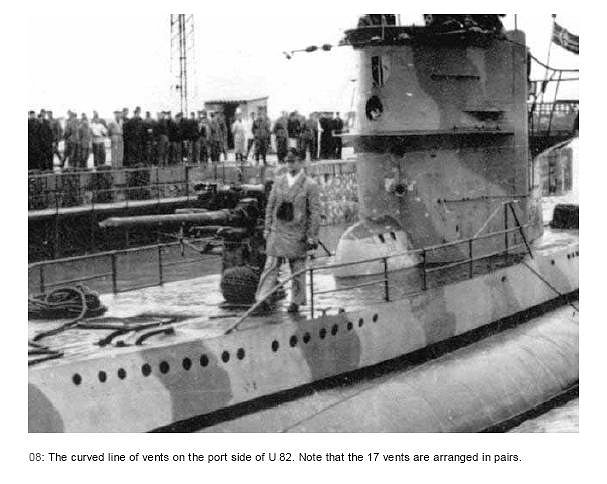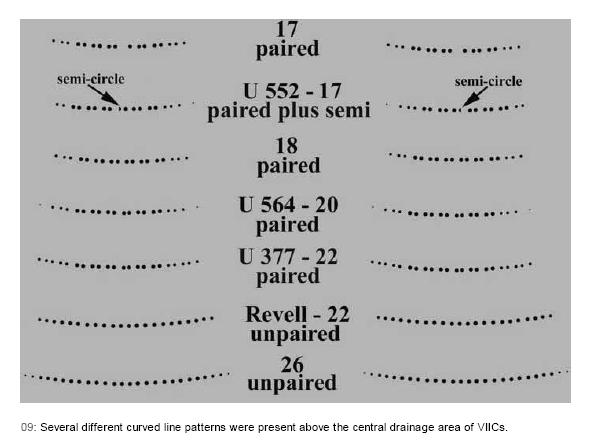You are viewing the archived version of the site.
Go to modelshipwrights.com for the current dynamic site!
Go to modelshipwrights.com for the current dynamic site!
Type VIIC Free-Flooding Vent Patterns
Two/three vents next to stem...

The medium-sized vents right next to the stem, above the level of the upper torpedo doors, are too large in size in the Revell kit. On the majority of VIICs there were three vents to port and two to starboard, rather than the three per side which feature on the Revell kit. Note also that the third vent from the stem on the port side was offset slightly from the second vent. Early Type VIIBs had only one vent next to the stem rather than the two/three that were present on VIICs. I have not seen any photos of late VIIBs in which this area of the hull casing is exposed, so I cannot say which pattern was present on the late VIIBs.
Twelve circular vents above torpedo doors
On each side of the hull, there were a line of twelve small circular vents located well above the upper torpedo door. Most U-boats had these vents arranged with an even space between them (unpaired). This unpaired pattern is the style present in the Revell kit.
A smaller proportion of U-boats had these vents arranged in pairs. The paired arrangement featured in Blohm & Voss boats such as U 552, U 556 and U 564. Should any of these boats be chosen as a subject, this line of vents on the Revell kit should be altered to a paired pattern.
One of the most noticeable inaccuracies in the Revell kit is that these twelve vents are much too large in the Revell kit. Since the line of vents is also too far forward in the Revell kit, it is easy enough to rectify both these problems: simply fill in the holes in the kit and drill new and smaller ones just aft of each of the filled holes.
Curved line of vents above central drainage area
The VIIBs and the earliest VIICs originally featured breakwaters (Revell parts 115 and 116) on the hull casing above the forward part of the central drainage area. These breakwaters were positioned outboard of the 88mm deck gun to help reduce the interference to the gun crew from waves. The boats with breakwaters included U 48, U 99, U 81, U 94, U 96, U 201, U 552 and U 556. The breakwaters were removed from Uboats (starting roughly in the spring of 1941) and replaced by a curved line of small circular vents of varying size. These vents allowed for a marginal improvement in diving times. Sometimes the vents in the curved line were evenly spaced (unpaired), as in the Revell kit, but more often the vents were arranged in pairs.

Below is a short listing of which boats had which patterns –
17 paired U 81, U 82, U 251, U 253 and U 565
17 paired plus semi U 552 (different to normal 17 paired pattern)
18 paired U 89, U 132, U 331
20 paired U 564
22 paired U 377
25 unpaired U 204 (as 26 unpaired but fill in 6th vent from rear)
26 unpaired U 93, U 94 and U 201
The Revell kit has 22 evenly-spaced (unpaired) vents, so four extra small holes need to be drilled on each side to replicate the 26 unpaired pattern. The paired patterns require more drilling and filling.
By December 1941 the policy of drilling extra vents in this area was discontinued. Every boat launched during December 1941 (and some before this date) did not have the curved lines. U 226, U 239, U 267, U 302, U 357, U 404, U 412, U 441, U995 and U 1064 are all examples of boats which never had these lines. The curved lines were gradually removed in operational boats over a period of time. There were even some U-boats such as U 203 which didn’t have the curved lines, even when other boats did.
Copyright ©2021 by Dougie Martindale. _OPINIONS Model Shipwrights, KitMaker Network, or Silver Star Enterrpises. Images also by copyright holder unless otherwise noted. Opinions expressed are those of the author(s) and not necessarily those of Model Shipwrights. All rights reserved. Originally published on: 2008-06-23 00:00:00. Unique Reads: 6337








